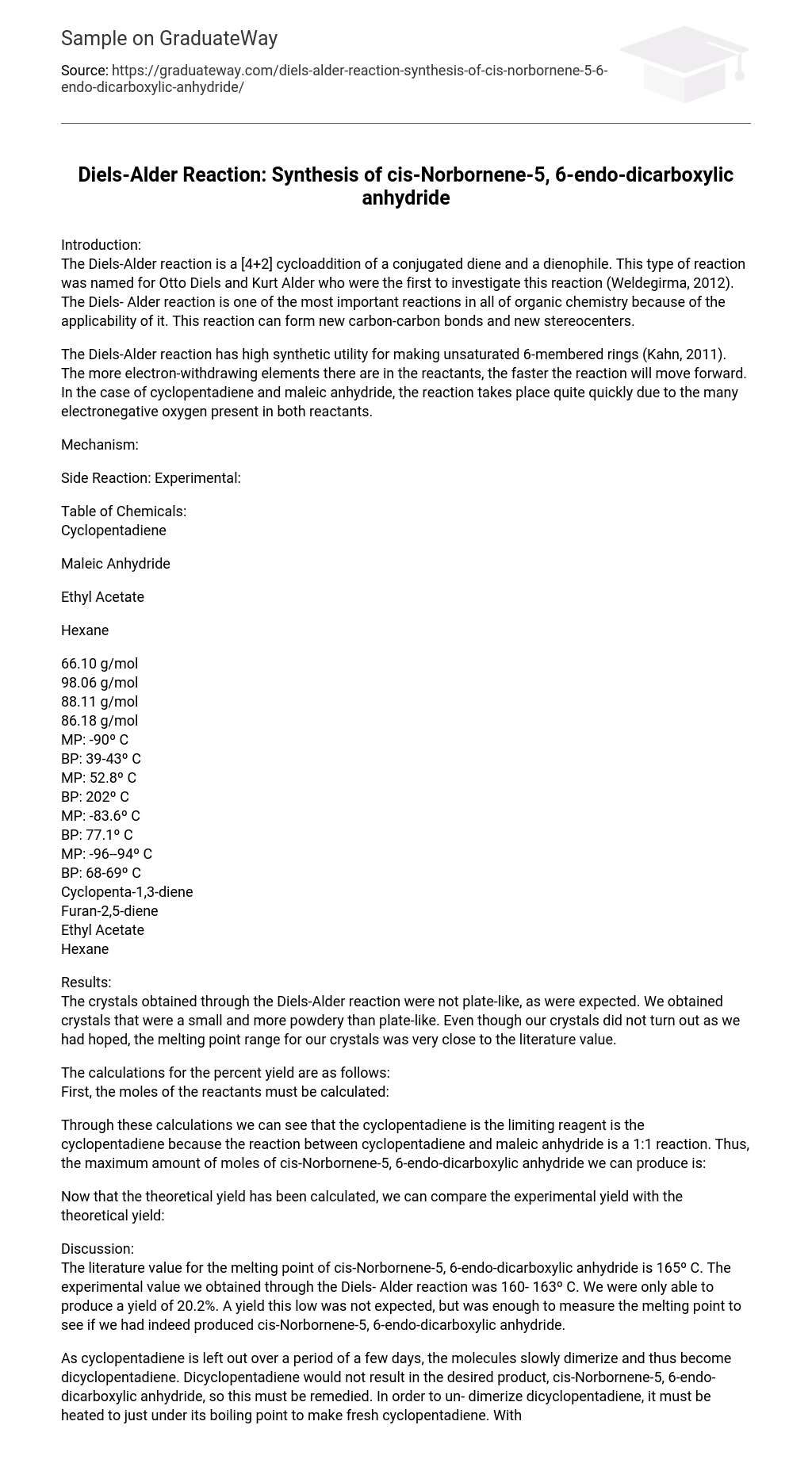Introduction:
The Diels-Alder reaction is a [4+2] cycloaddition of a conjugated diene and a dienophile. This type of reaction was named for Otto Diels and Kurt Alder who were the first to investigate this reaction (Weldegirma, 2012). The Diels- Alder reaction is one of the most important reactions in all of organic chemistry because of the applicability of it. This reaction can form new carbon-carbon bonds and new stereocenters.
The Diels-Alder reaction has high synthetic utility for making unsaturated 6-membered rings (Kahn, 2011). The more electron-withdrawing elements there are in the reactants, the faster the reaction will move forward. In the case of cyclopentadiene and maleic anhydride, the reaction takes place quite quickly due to the many electronegative oxygen present in both reactants.
Mechanism:
Side Reaction: Experimental:
Table of Chemicals:
Cyclopentadiene
Maleic Anhydride
Ethyl Acetate
Hexane
66.10 g/mol
98.06 g/mol
88.11 g/mol
86.18 g/mol
MP: -90º C
BP: 39-43º C
MP: 52.8º C
BP: 202º C
MP: -83.6º C
BP: 77.1º C
MP: -96–94º C
BP: 68-69º C
Cyclopenta-1,3-diene
Furan-2,5-diene
Ethyl Acetate
Hexane
Results:
The crystals obtained through the Diels-Alder reaction were not plate-like, as were expected. We obtained crystals that were a small and more powdery than plate-like. Even though our crystals did not turn out as we had hoped, the melting point range for our crystals was very close to the literature value.
The calculations for the percent yield are as follows:
First, the moles of the reactants must be calculated:
Through these calculations we can see that the cyclopentadiene is the limiting reagent is the cyclopentadiene because the reaction between cyclopentadiene and maleic anhydride is a 1:1 reaction. Thus, the maximum amount of moles of cis-Norbornene-5, 6-endo-dicarboxylic anhydride we can produce is:
Now that the theoretical yield has been calculated, we can compare the experimental yield with the theoretical yield:
Discussion:
The literature value for the melting point of cis-Norbornene-5, 6-endo-dicarboxylic anhydride is 165º C. The experimental value we obtained through the Diels- Alder reaction was 160- 163º C. We were only able to produce a yield of 20.2%. A yield this low was not expected, but was enough to measure the melting point to see if we had indeed produced cis-Norbornene-5, 6-endo-dicarboxylic anhydride.
As cyclopentadiene is left out over a period of a few days, the molecules slowly dimerize and thus become dicyclopentadiene. Dicyclopentadiene would not result in the desired product, cis-Norbornene-5, 6-endo-dicarboxylic anhydride, so this must be remedied. In order to un- dimerize dicyclopentadiene, it must be heated to just under its boiling point to make fresh cyclopentadiene. With our melting point being so close to the literature value for cis-Norbornene-5, 6-endo-dicarboxylic anhydride, it is very likely that the desired product was obtained.
This reaction does not seem to be very efficient at all. By using 0.2mL of cyclopentadiene, we only were able to produce about 0.05g which, at a 20.2% yield, is very low. Conclusion:
The Diels- Alder reaction is one of the most important types of reactions in organic chemistry (Weldegirma, 2012). This reaction is so important because of its ability to form new carbon-carbon bonds. Diels- Alder reactions are used constantly in the medical field due to its diverse uses. It has been in studies of ribozymes and creating ribozymes synthetically (Jaschke, 2000).
I believe that we did accomplish what we set out to do in this lab. We were able to form cis-Norbornene-5, 6-endo-dicarboxylic anhydride crystals and were able to achieve a very pure product.
References:
1) Reusch, Rosetta N. “Chemical Reactivity.” Chemical Reactivity. Michigan State University, n.d. Web. 14 Sept. 2013. 2) Jaschke, A.; Seeling, B.; Keiper, S.; Stuhlmann, F. Angew. Chem. Int. Ed. 2000, 39, 4576-4579. Enantioselective Ribozyme Catalysis of a Bimolecular Cycloaddition Reaction. 3) Weldegirma, Solomon. “Experiment 2: Diels-Alder Reaction: Synthesis of cis-Norbornene-5, 6-endo-dicarboxylic anhydride.” Experimental Organic
Chemisty. Fall 2012 ed. Mason: Cengage Learning, 2012. 05 Mar. 2013. Print





